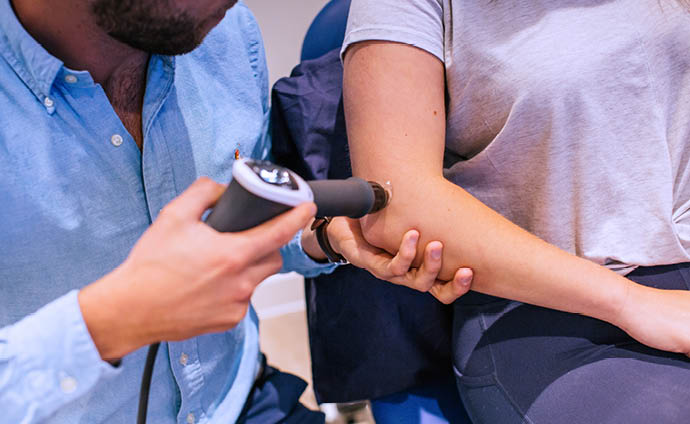Rob Foyster is one of the Directors and Lead Physiotherapists at Spectrum’s London clinic. He specialises in musculoskeletal conditions, spinal rehabilitation and is passionate about helping patients achieve their health-related goals and staying pain-free.
This is a real case study from one of his recent patients, a mid-fifties female who was suffering from elbow pain, which he diagnosed as ‘tennis elbow’. The following words, written by Rob, will give you an insight into what it’s like being treated at Spectrum —from assessment right through to discharge.
I had a patient come in to see me, a 54-year-old lawyer who was struggling with elbow pain in her dominant arm. Given her profession, she spent a lot of time at her computer in the same position and was also an avid tennis player. Basically, everything she was doing — from sitting and typing for hours per day, through to swinging a tennis racket was compounding her pain.
Despite her telling me she played tennis, I still undertook a full assessment before diagnosing her condition. While the condition commonly known as tennis elbow can be caused or exacerbated by playing tennis, it’s not only tennis players who suffer from it and vice-versa, so I didn’t want to jump to any conclusions. But in her case, I found that she had severe inflammation on the outside of the elbow, specifically in the attachment site of the tendon where tennis elbow occurs, so after a number of tests I was able to determine this was what was going on.
Tennis elbow is one of those conditions that is often caused by a lack of strength and poor posture as well as repetitive strain, which was certainly the case with this patient. Her posture was rounded through the shoulders, which was decreasing the congruence of her shoulder joint and that was then impacting on her elbow, on top of the overload problem she was suffering from.

Once I was clear on the diagnosis, I discussed her treatment options with her. One of the unique therapies we have on offer at Spectrum is called Shockwave therapy. It isn’t overly common for a clinic to have their own Shockwave machine (and include Shockwave in the price of a standard consultation!) as they are extremely expensive pieces of equipment, but it is something we are able to offer patients who come into our London clinic. However, when offering patients the option of Shockwave for the first time, I am always conscious of running them through the pros and cons of this type of therapy.
Essentially the pros are that it is often the fastest way to make a full recovery and get back to full strength and being pain-free. The irony of this is that the main con is pain! Being a more invasive treatment method than traditional physio, Shockwave can actually be a bit painful when you’re undergoing it. Essentially, I wanted to make sure my patient understood that the treatment itself could hurt a bit and initially she may even feel a little bit more sore for the first few days after a session. I have learned over the years that some patients would prefer to try conservative management or traditional physio first to see if that will clear up an injury, whereas others think that if Shockwave will help them get better quicker they’re happy to put up with a couple of minutes worth of pain.
Once my patient decided that Shockwave was the best course of action for her, we began the first of the six sessions (which is the standard length of treatment). We combined the Shockwave with isometric exercises that help to strengthen the muscles in a safe way. After the first session she reported feeling a bit more sore than before as expected, but by the second session we were already seeing massive improvements. She described what she was feeling as going “from a constant ache with sharp pains” when performing certain movements like swinging a tennis racket, or even typing for more than five minutes to feeling no constant pain whatsoever and less intense pain when performing aggravating movements. By the sixth and final session she was pain free and back to playing tennis!
Do you want to book an appointment with Rob or one of Spectrum’s other physiotherapists? Secure a time that suits you via our website.



